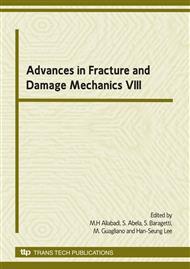p.241
p.245
p.249
p.253
p.257
p.261
p.265
p.269
p.273
Fatigue Crack Propagation in Thin Structures
Abstract:
The influence of specimen thickness on fatigue crack behaviour has been investigated. To this aim the fatigue crack propagation rate has been measured on two different types of test specimens with varying thickness. The change of stress singularity exponent for the crack front due to vicinity of the free surface is considered. To explain the effect of stress singularity changes on obtained experimental results a methodology based on generalized stress intensity factor and strain energy density concept has been used. It is shown that for materials with Poisson’s ratio of about 0.3 the free surface effect does not play a decisive role for specimens with a low level of in-plane constraint but can influence fatigue crack propagation rate in the case of geometries with a high level of the constraint.
Info:
Periodical:
Pages:
257-260
Citation:
Online since:
October 2009
Authors:
Keywords:
Price:
Сopyright:
© 2010 Trans Tech Publications Ltd. All Rights Reserved
Share:
Citation:


